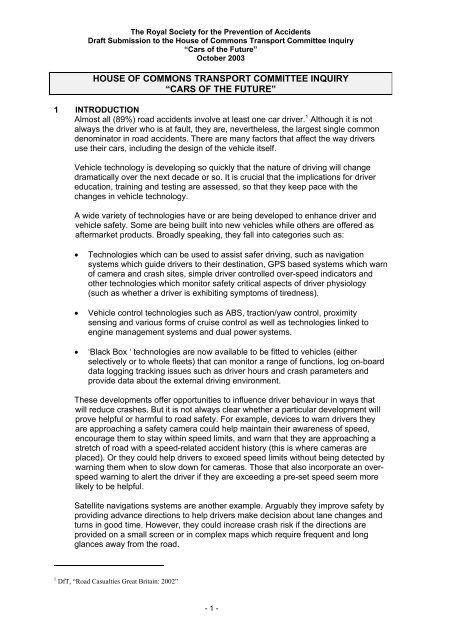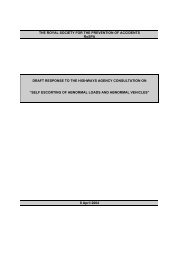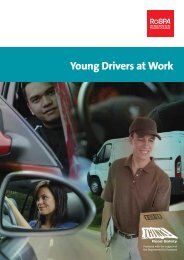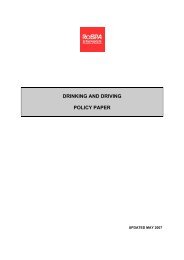Response to Transport Committee Cars of the Future ... - RoSPA
Response to Transport Committee Cars of the Future ... - RoSPA
Response to Transport Committee Cars of the Future ... - RoSPA
Create successful ePaper yourself
Turn your PDF publications into a flip-book with our unique Google optimized e-Paper software.
The Royal Society for <strong>the</strong> Prevention <strong>of</strong> Accidents<br />
Draft Submission <strong>to</strong> <strong>the</strong> House <strong>of</strong> Commons <strong>Transport</strong> <strong>Committee</strong> Inquiry<br />
“<strong>Cars</strong> <strong>of</strong> <strong>the</strong> <strong>Future</strong>”<br />
Oc<strong>to</strong>ber 2003<br />
HOUSE OF COMMONS TRANSPORT COMMITTEE INQUIRY<br />
“CARS OF THE FUTURE”<br />
1 INTRODUCTION<br />
Almost all (89%) road accidents involve at least one car driver. 1 Although it is not<br />
always <strong>the</strong> driver who is at fault, <strong>the</strong>y are, never<strong>the</strong>less, <strong>the</strong> largest single common<br />
denomina<strong>to</strong>r in road accidents. There are many fac<strong>to</strong>rs that affect <strong>the</strong> way drivers<br />
use <strong>the</strong>ir cars, including <strong>the</strong> design <strong>of</strong> <strong>the</strong> vehicle itself.<br />
Vehicle technology is developing so quickly that <strong>the</strong> nature <strong>of</strong> driving will change<br />
dramatically over <strong>the</strong> next decade or so. It is crucial that <strong>the</strong> implications for driver<br />
education, training and testing are assessed, so that <strong>the</strong>y keep pace with <strong>the</strong><br />
changes in vehicle technology.<br />
A wide variety <strong>of</strong> technologies have or are being developed <strong>to</strong> enhance driver and<br />
vehicle safety. Some are being built in<strong>to</strong> new vehicles while o<strong>the</strong>rs are <strong>of</strong>fered as<br />
aftermarket products. Broadly speaking, <strong>the</strong>y fall in<strong>to</strong> categories such as:<br />
• Technologies which can be used <strong>to</strong> assist safer driving, such as navigation<br />
systems which guide drivers <strong>to</strong> <strong>the</strong>ir destination, GPS based systems which warn<br />
<strong>of</strong> camera and crash sites, simple driver controlled over-speed indica<strong>to</strong>rs and<br />
o<strong>the</strong>r technologies which moni<strong>to</strong>r safety critical aspects <strong>of</strong> driver physiology<br />
(such as whe<strong>the</strong>r a driver is exhibiting symp<strong>to</strong>ms <strong>of</strong> tiredness).<br />
• Vehicle control technologies such as ABS, traction/yaw control, proximity<br />
sensing and various forms <strong>of</strong> cruise control as well as technologies linked <strong>to</strong><br />
engine management systems and dual power systems.<br />
• ‘Black Box ‘ technologies are now available <strong>to</strong> be fitted <strong>to</strong> vehicles (ei<strong>the</strong>r<br />
selectively or <strong>to</strong> whole fleets) that can moni<strong>to</strong>r a range <strong>of</strong> functions, log on-board<br />
data logging tracking issues such as driver hours and crash parameters and<br />
provide data about <strong>the</strong> external driving environment.<br />
These developments <strong>of</strong>fer opportunities <strong>to</strong> influence driver behaviour in ways that<br />
will reduce crashes. But it is not always clear whe<strong>the</strong>r a particular development will<br />
prove helpful or harmful <strong>to</strong> road safety. For example, devices <strong>to</strong> warn drivers <strong>the</strong>y<br />
are approaching a safety camera could help maintain <strong>the</strong>ir awareness <strong>of</strong> speed,<br />
encourage <strong>the</strong>m <strong>to</strong> stay within speed limits, and warn that <strong>the</strong>y are approaching a<br />
stretch <strong>of</strong> road with a speed-related accident his<strong>to</strong>ry (this is where cameras are<br />
placed). Or <strong>the</strong>y could help drivers <strong>to</strong> exceed speed limits without being detected by<br />
warning <strong>the</strong>m when <strong>to</strong> slow down for cameras. Those that also incorporate an overspeed<br />
warning <strong>to</strong> alert <strong>the</strong> driver if <strong>the</strong>y are exceeding a pre-set speed seem more<br />
likely <strong>to</strong> be helpful.<br />
Satellite navigations systems are ano<strong>the</strong>r example. Arguably <strong>the</strong>y improve safety by<br />
providing advance directions <strong>to</strong> help drivers make decision about lane changes and<br />
turns in good time. However, <strong>the</strong>y could increase crash risk if <strong>the</strong> directions are<br />
provided on a small screen or in complex maps which require frequent and long<br />
glances away from <strong>the</strong> road.<br />
1 DfT, “Road Casualties Great Britain: 2002”<br />
- 1 -
The Royal Society for <strong>the</strong> Prevention <strong>of</strong> Accidents<br />
Draft Submission <strong>to</strong> <strong>the</strong> House <strong>of</strong> Commons <strong>Transport</strong> <strong>Committee</strong> Inquiry<br />
“<strong>Cars</strong> <strong>of</strong> <strong>the</strong> <strong>Future</strong>”<br />
Oc<strong>to</strong>ber 2003<br />
There is also a potential problem <strong>of</strong> ‘risk compensation with drivers using up safety<br />
margins created by new safety technologies.<br />
Intelligent Speed Adaptation<br />
One <strong>of</strong> <strong>the</strong> most significant developments is Intelligent Speed Adaptation. This would<br />
involve satellites communicating with vehicles <strong>to</strong> reduce <strong>the</strong>ir speed by ei<strong>the</strong>r<br />
advising <strong>the</strong> driver <strong>to</strong> do so or by physically preventing <strong>the</strong> vehicle from exceeding<br />
<strong>the</strong> posted speed limit on <strong>the</strong> road in question.<br />
The technology can be designed <strong>to</strong> simply alert <strong>the</strong> driver <strong>to</strong> <strong>the</strong> prevailing speed<br />
limit and warn him or her <strong>to</strong> reduce <strong>the</strong>ir speed, or <strong>to</strong> actively control <strong>the</strong> vehicle’s<br />
speed but allowing <strong>the</strong> driver <strong>to</strong> switch <strong>the</strong> system on or <strong>of</strong>f, or <strong>to</strong> au<strong>to</strong>matically limit<br />
<strong>the</strong> vehicle’s maximum speed, whe<strong>the</strong>r <strong>the</strong> driver likes it or not.<br />
As well as enforcing speed limits, a dynamic System could set lower speed limits at<br />
dangerous spots, such as sharp bends, or in response <strong>to</strong> <strong>the</strong> prevailing conditions,<br />
such as fog or ice.<br />
Trials by Leeds University and <strong>the</strong> Mo<strong>to</strong>r Industry Research Association (MIRA) 2<br />
have shown that <strong>the</strong> technology can successfully reduce excessive speed,<br />
particularly in areas where drivers were renowned for being poor at adapting <strong>the</strong>ir<br />
speed, for example in rural villages. The predicted levels <strong>of</strong> crash reduction are<br />
substantial. 3<br />
Predicted Accident reductions from ISA in Great Britain<br />
Intervention Level Speed Limit System<br />
Fixed Variable Dynamic<br />
Advisory 10% 10% 13%<br />
Driver Select 10% 11% 18%<br />
Manda<strong>to</strong>ry 20% 22% 36% (59%<br />
reduction in<br />
fatal accidents)<br />
The implementation <strong>of</strong> this technology is predicted <strong>to</strong> take almost 20 years, allowing<br />
time for fur<strong>the</strong>r research and development, <strong>the</strong> development <strong>of</strong> standards, for <strong>the</strong><br />
mo<strong>to</strong>r industry <strong>to</strong> produce ISA vehicles and <strong>the</strong>n for <strong>the</strong> number <strong>of</strong> vehicles fitted<br />
with ISA technology <strong>to</strong> become a high enough proportion <strong>of</strong> <strong>the</strong> overall vehicle parc<br />
for manda<strong>to</strong>ry use <strong>to</strong> be feasible.<br />
An essential step is <strong>the</strong> production <strong>of</strong> a digital road map which would contain all <strong>of</strong><br />
<strong>the</strong> roads in <strong>the</strong> UK and <strong>the</strong>ir respective speed limits. The <strong>Transport</strong>, Local<br />
Government and <strong>the</strong> Regions report <strong>of</strong> <strong>the</strong>ir Inquiry in<strong>to</strong> Road Traffic Speed (June<br />
2002) 4 recommended that <strong>the</strong> government fund <strong>the</strong> development <strong>of</strong> a digital road<br />
map.<br />
2 User trials with intelligent speed limiters; Behavioural Research in Road Safety: Tenth Seminar: DTLR<br />
3 O <strong>Cars</strong>ten, “Intelligent Speed Adaptation”, University <strong>of</strong> Leeds, Proceedings <strong>of</strong> <strong>RoSPA</strong> 67 th Road Safety Congress,<br />
“Safer Driving: <strong>the</strong> Road <strong>to</strong> Success”, March 2002<br />
4 The <strong>Transport</strong>, Local Government and <strong>the</strong> Regions Report, “Road Traffic Speed”, June 2002<br />
- 2 -
The Royal Society for <strong>the</strong> Prevention <strong>of</strong> Accidents<br />
Draft Submission <strong>to</strong> <strong>the</strong> House <strong>of</strong> Commons <strong>Transport</strong> <strong>Committee</strong> Inquiry<br />
“<strong>Cars</strong> <strong>of</strong> <strong>the</strong> <strong>Future</strong>”<br />
Oc<strong>to</strong>ber 2003<br />
Employers<br />
Vehicle technology <strong>of</strong>fers excellent opportunities for employers <strong>to</strong> moni<strong>to</strong>r <strong>the</strong> driving<br />
<strong>of</strong> <strong>the</strong>ir staff who drive for work, identify high risk drivers or journeys and take<br />
appropriate action <strong>to</strong> reduce <strong>the</strong>se risks. The HSE, with DfT, have published a<br />
Guide, “Driving at work” 5 , that states “health and safety law applies <strong>to</strong> on-<strong>the</strong>-road<br />
work activities … and <strong>the</strong> risks should be effectively managed within a health and<br />
safety system”. There are a number <strong>of</strong> products which can be used <strong>to</strong> help drivers,<br />
and fleet opera<strong>to</strong>rs, evaluate <strong>the</strong>ir performance and reduce risks.<br />
Journey Data Recorders (JDRs)<br />
These can record information about how <strong>the</strong> car is driven, from <strong>the</strong> tachograph (if<br />
fitted), speedometer, rev counter, fuel flow meter and brakes. The information can<br />
be downloaded for analysis <strong>to</strong> highlight drivers who are not driving safely or<br />
economically. Some systems include dashboard warning lights <strong>to</strong> alert <strong>the</strong> driver if<br />
<strong>the</strong>y are driving dangerously or uneconomically. Case studies have shown that <strong>the</strong>y<br />
can help <strong>to</strong> reduce both costs and incidents and improve fuel consumption. 6<br />
Accident Data Recorders (ADRs)<br />
The ‘black box’ well known in <strong>the</strong> investigation <strong>of</strong> aircraft incidents, is now being<br />
fitted <strong>to</strong> cars and o<strong>the</strong>r vehicles <strong>to</strong> find out why and how an incident happened.<br />
They record incident information such as acceleration, braking and movement <strong>of</strong> a<br />
vehicle before and during an accident. Research in <strong>the</strong> Ne<strong>the</strong>rlands 7 , which<br />
assessed whe<strong>the</strong>r drivers who know <strong>the</strong>y are being moni<strong>to</strong>red and who receive<br />
feedback from <strong>the</strong> information collected, change <strong>the</strong>ir driving behaviour, found a<br />
reduction in accident risk <strong>of</strong> about 20% on average, although <strong>the</strong> effect varied<br />
considerably between <strong>the</strong> different vehicle fleets. Research in Great Britain found<br />
that <strong>the</strong> use <strong>of</strong> ADR’s in nine different fleets with a <strong>to</strong>tal <strong>of</strong> 341 vehicles 6 over a 12<br />
month period reduced incidents by 28% and costs by 40%. The project<br />
More work is needed <strong>to</strong> establish consensus about what managers and drivers need<br />
<strong>to</strong> know <strong>to</strong> be able <strong>to</strong> assess/moni<strong>to</strong>r driving behaviour. However, given that 20<br />
deaths and 250 serious injuries occur every week in road accidents in accidents in<br />
which someone was at work at <strong>the</strong> time 5 , action by employers <strong>to</strong> reduce <strong>the</strong>se<br />
crashes could substantially reduce death and injury on <strong>the</strong> road.<br />
Vulnerable Road Users<br />
The crash tests developed by <strong>the</strong> European Enhanced Vehicle Safety <strong>Committee</strong><br />
Working Group 17 and <strong>the</strong> EURONCAP programme have helped <strong>to</strong> substantially<br />
improve <strong>the</strong> design <strong>of</strong> cars so <strong>the</strong>y cause less severe injury <strong>to</strong> pedestrians and<br />
o<strong>the</strong>rs. It was extremely disappointing that <strong>the</strong> EC decided against a Directive which<br />
would have required new cars <strong>to</strong> meet <strong>the</strong>se tests. This would have saved an<br />
estimated 2,000 lives and 18,000 serious injuries annually on EU roads. Instead,<br />
<strong>the</strong> EC has approved a directive that will require by 2005 new cars <strong>to</strong> pass less<br />
stringent tests developed by <strong>the</strong> mo<strong>to</strong>r industry.<br />
5 HSE, ”Driving at Work”, September 2003, INDG382<br />
6 Driver Safety: Moni<strong>to</strong>ring; Fleet Safety Forum, Brake<br />
7 Wouters & Bos: Traffic accident reduction by moni<strong>to</strong>ring driver behaviour with in-car data recorders: Accident<br />
Analysis & Prevention: Vol 32, No 5<br />
- 3 -
The Royal Society for <strong>the</strong> Prevention <strong>of</strong> Accidents<br />
Draft Submission <strong>to</strong> <strong>the</strong> House <strong>of</strong> Commons <strong>Transport</strong> <strong>Committee</strong> Inquiry<br />
“<strong>Cars</strong> <strong>of</strong> <strong>the</strong> <strong>Future</strong>”<br />
Oc<strong>to</strong>ber 2003<br />
In-Car Child Safety<br />
An area has progressed very slowly is <strong>the</strong> introduction <strong>of</strong> <strong>the</strong> ISOfix system for child<br />
car restraints. ISOFIX is intended <strong>to</strong> make fitting child seats in<strong>to</strong> cars quick and<br />
simple. ISOFIX points are be built in<strong>to</strong> cars at <strong>the</strong> point <strong>of</strong> manufacture and child<br />
seats will have ISOFIX fitting points so that <strong>the</strong>y can be simply plugged in<strong>to</strong> <strong>the</strong><br />
points in <strong>the</strong> car. This is an essential development because many people find it<br />
difficult <strong>to</strong> fit chid seats correctly, and surveys consistently find that a high proportion<br />
<strong>of</strong> child seats are not fitted securely. ISOFIX is designed <strong>to</strong> solve all <strong>the</strong>se problems.<br />
At least one ISOFIX seats is already available in <strong>the</strong> UK, but it has <strong>to</strong> be tested and<br />
approved for specific models <strong>of</strong> car. The ultimate aim is that any child car seat will fit<br />
any car.<br />
Conclusion<br />
Vehicle technology is, and always will, rapidly develop and change. It <strong>of</strong>fers many<br />
opportunities for influencing <strong>the</strong> way we drive. Over <strong>the</strong> next two decades it seems<br />
certain that <strong>the</strong> nature <strong>of</strong> cars, and hence <strong>the</strong> nature <strong>of</strong> driving, will change<br />
fundamentally. In particular, <strong>the</strong> long term development <strong>of</strong> Intelligent Speed<br />
Adaptation <strong>of</strong>fers very significant opportunities for influencing drivers’ choice and use<br />
<strong>of</strong> speed, and <strong>the</strong>reby significantly reducing deaths and injuries.<br />
However, it is crucial that <strong>the</strong> implications for driver education, driver training and<br />
driver testing are assessed and unders<strong>to</strong>od, so that training and testing regimes can<br />
be adapted <strong>to</strong> <strong>the</strong> changes, and so that drivers understand <strong>the</strong> benefits and<br />
limitations <strong>of</strong> new car technology.<br />
There is a strong case for a comprehensive review <strong>of</strong> <strong>the</strong> potential effects on driver<br />
behaviour and crash risk <strong>of</strong> individual technological developments and <strong>of</strong> <strong>the</strong> change<br />
in cars overall, perhaps undertaken by a suitable centre <strong>of</strong> excellence such as<br />
Qinetiq, TRL, MIRA or a major university department.<br />
It seems that <strong>the</strong> vehicles <strong>the</strong>mselves will do more and more <strong>of</strong> <strong>the</strong> driving and<br />
decision-making. The science fiction <strong>of</strong> <strong>the</strong> driver being little more than a passenger<br />
in a fully au<strong>to</strong>mated car is on its way <strong>to</strong> becoming science fact.<br />
- 4 -
















